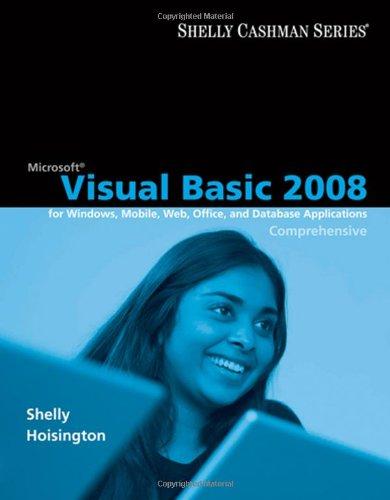Answered step by step
Verified Expert Solution
Question
1 Approved Answer
can you please write/make all that for me based on these photos down below this text P2 Rubrics - Reporting (2%) - ERD Design Process
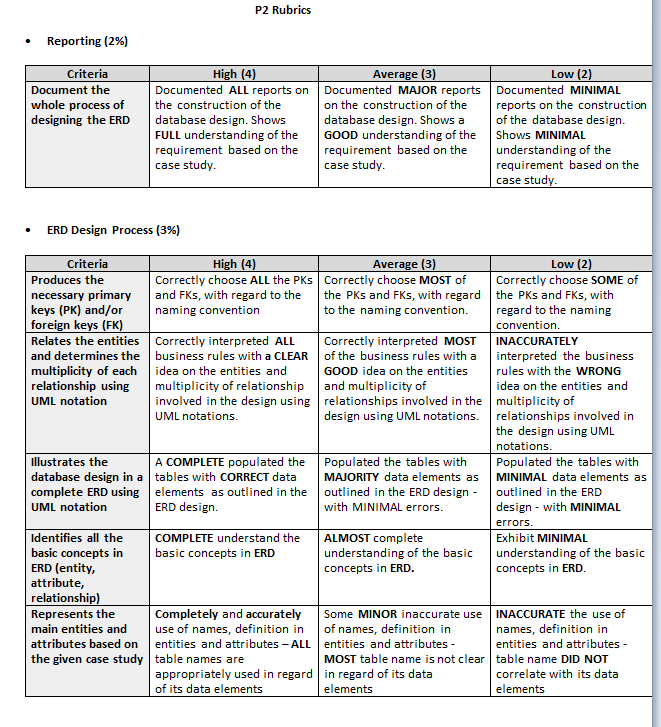
can you please write/make all that for me based on these photos down below this text
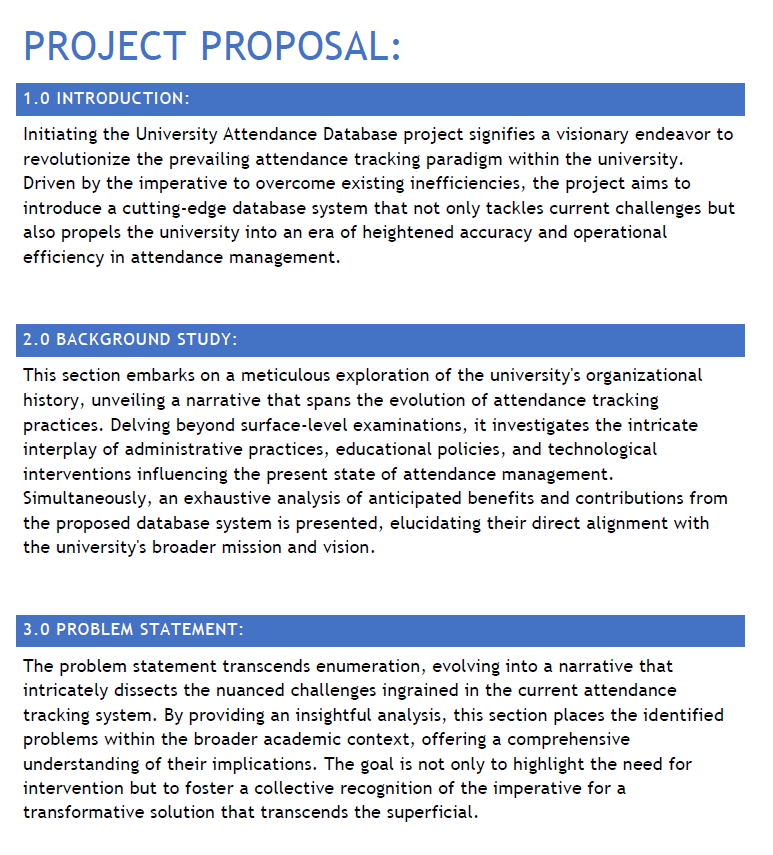
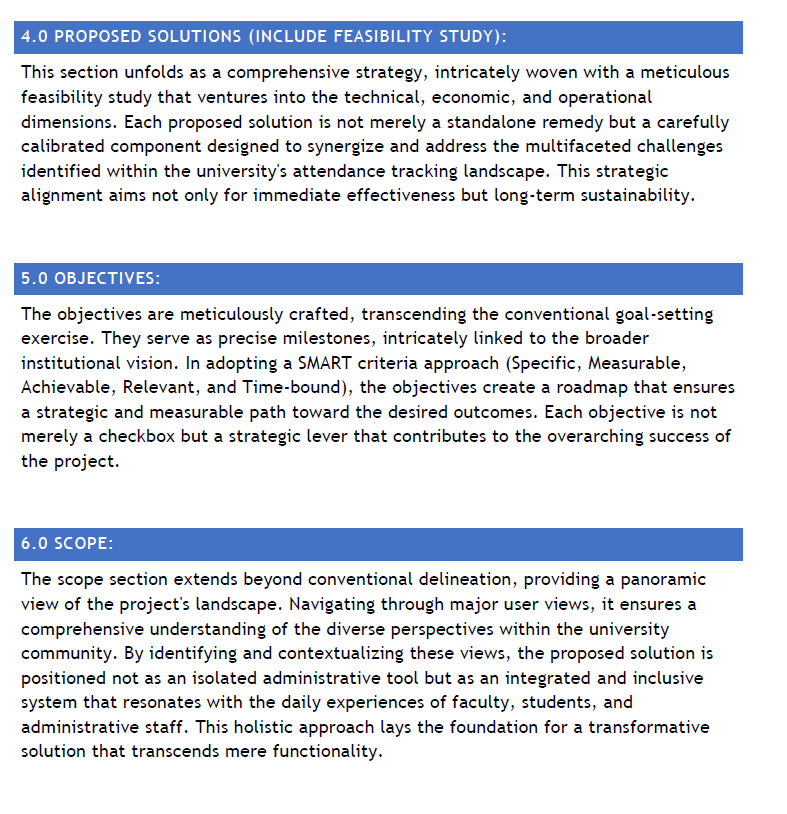
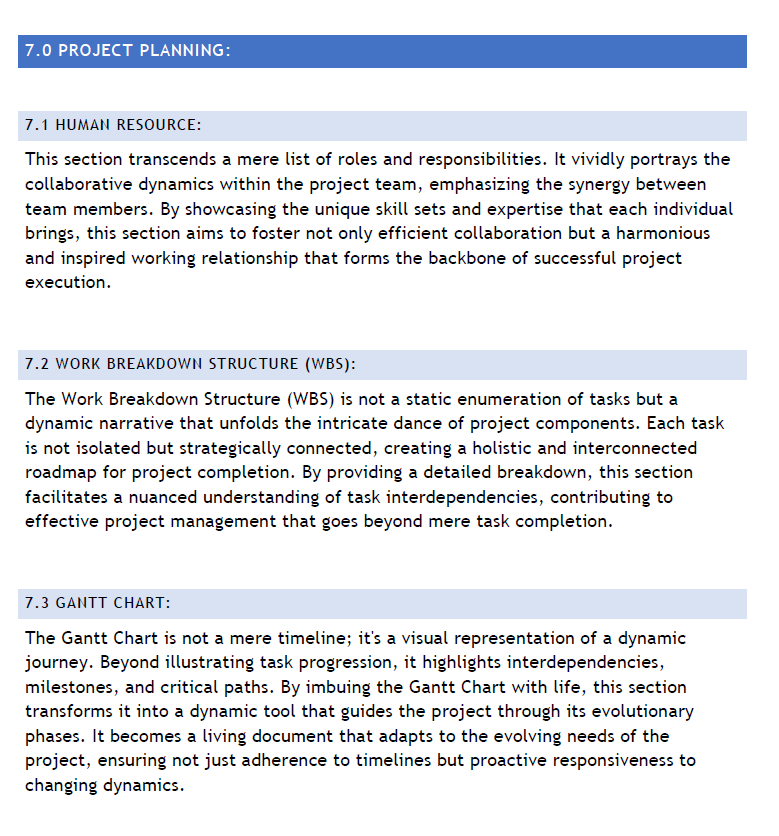
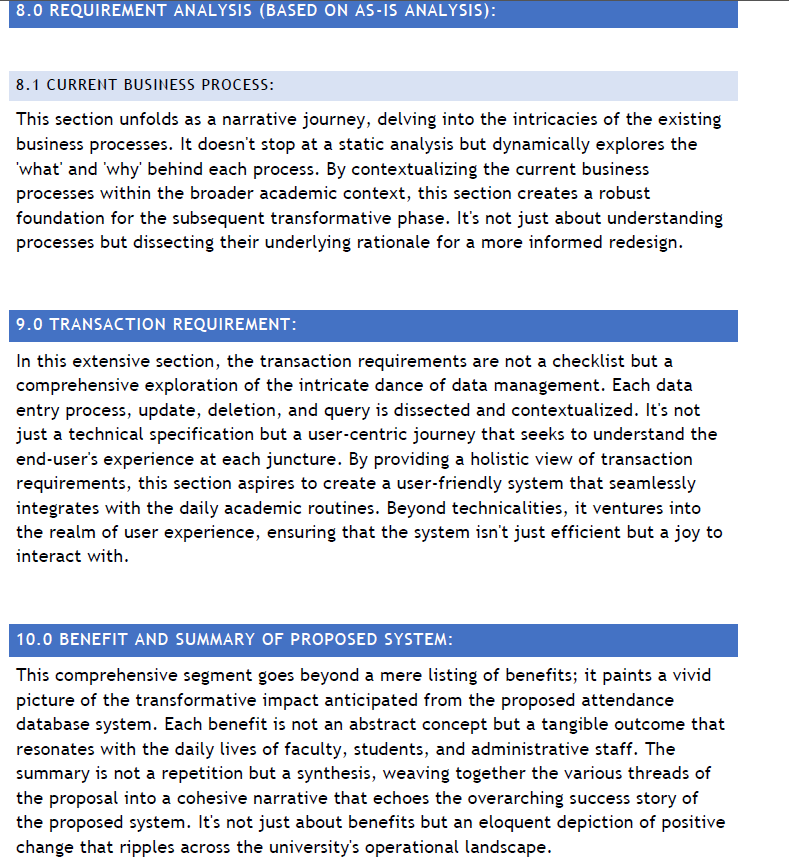
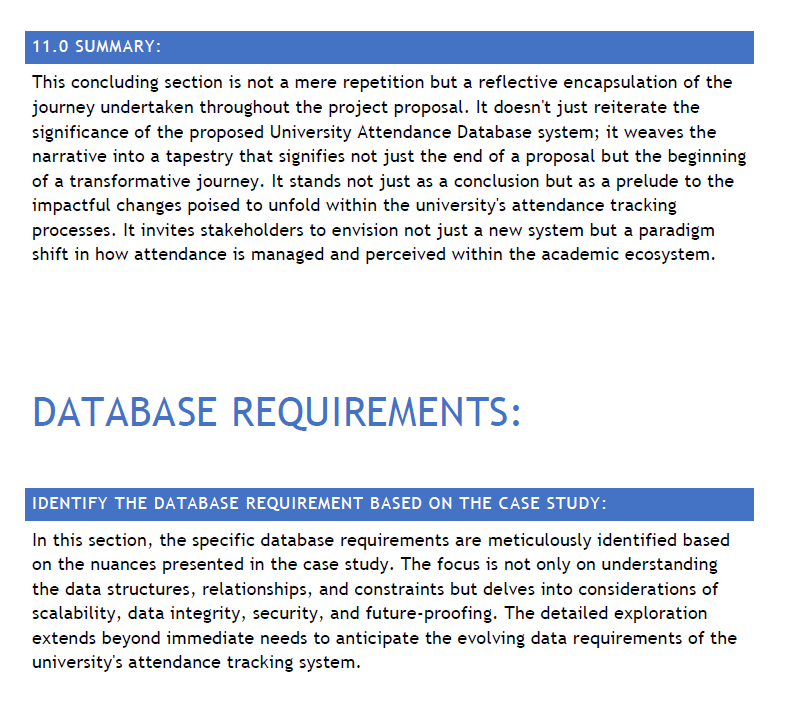
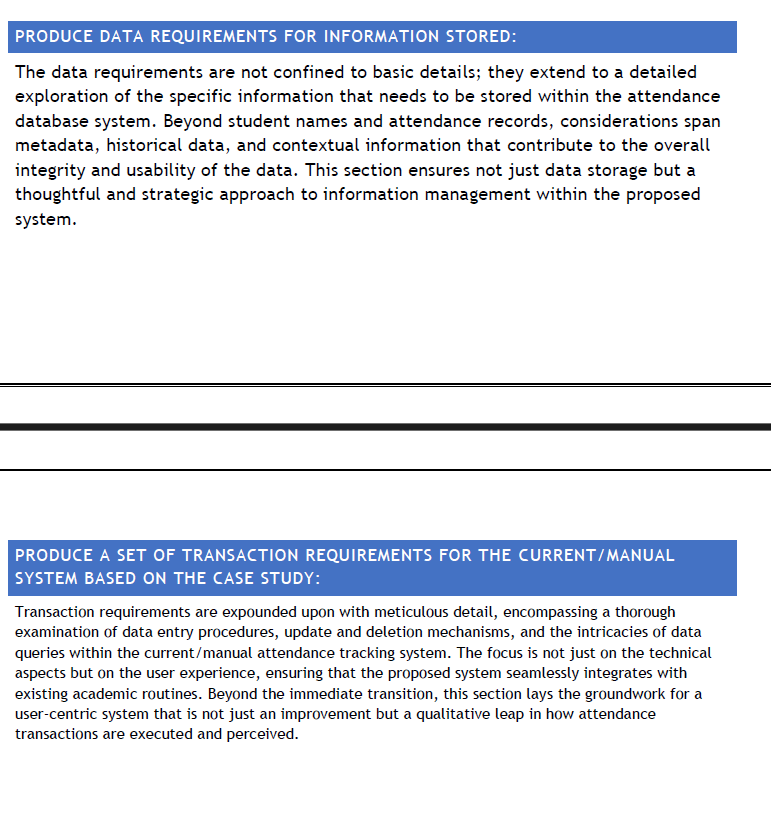 P2 Rubrics - Reporting (2%) - ERD Design Process (3\%) PROJECT PROPOSAL: 1.0 INTRODUCTION: Initiating the University Attendance Database project signifies a visionary endeavor to revolutionize the prevailing attendance tracking paradigm within the university. Driven by the imperative to overcome existing inefficiencies, the project aims to introduce a cutting-edge database system that not only tackles current challenges but also propels the university into an era of heightened accuracy and operational efficiency in attendance management. 2.0 BACKGROUND STUDY: This section embarks on a meticulous exploration of the university's organizational history, unveiling a narrative that spans the evolution of attendance tracking practices. Delving beyond surface-level examinations, it investigates the intricate interplay of administrative practices, educational policies, and technological interventions influencing the present state of attendance management. Simultaneously, an exhaustive analysis of anticipated benefits and contributions from the proposed database system is presented, elucidating their direct alignment with the university's broader mission and vision. 3.0 PROBLEM STATEMENT: The problem statement transcends enumeration, evolving into a narrative that intricately dissects the nuanced challenges ingrained in the current attendance tracking system. By providing an insightful analysis, this section places the identified problems within the broader academic context, offering a comprehensive understanding of their implications. The goal is not only to highlight the need for intervention but to foster a collective recognition of the imperative for a transformative solution that transcends the superficial. 4.0 PROPOSED SOLUTIONS (INCLUDE FEASIBILITY STUDY): This section unfolds as a comprehensive strategy, intricately woven with a meticulous feasibility study that ventures into the technical, economic, and operational dimensions. Each proposed solution is not merely a standalone remedy but a carefully calibrated component designed to synergize and address the multifaceted challenges identified within the university's attendance tracking landscape. This strategic alignment aims not only for immediate effectiveness but long-term sustainability. 5. 0 OBJECTIVES: The objectives are meticulously crafted, transcending the conventional goal-setting exercise. They serve as precise milestones, intricately linked to the broader institutional vision. In adopting a SMART criteria approach (Specific, Measurable, Achievable, Relevant, and Time-bound), the objectives create a roadmap that ensures a strategic and measurable path toward the desired outcomes. Each objective is not merely a checkbox but a strategic lever that contributes to the overarching success of the project. 6.0 SCOPE: The scope section extends beyond conventional delineation, providing a panoramic view of the project's landscape. Navigating through major user views, it ensures a comprehensive understanding of the diverse perspectives within the university community. By identifying and contextualizing these views, the proposed solution is positioned not as an isolated administrative tool but as an integrated and inclusive system that resonates with the daily experiences of faculty, students, and administrative staff. This holistic approach lays the foundation for a transformative solution that transcends mere functionality. 7.1 HUMAN RESOURCE: This section transcends a mere list of roles and responsibilities. It vividly portrays the collaborative dynamics within the project team, emphasizing the synergy between team members. By showcasing the unique skill sets and expertise that each individual brings, this section aims to foster not only efficient collaboration but a harmonious and inspired working relationship that forms the backbone of successful project execution. 7.2 WORK BREAKDOWN STRUCTURE (WBS): The Work Breakdown Structure (WBS) is not a static enumeration of tasks but a dynamic narrative that unfolds the intricate dance of project components. Each task is not isolated but strategically connected, creating a holistic and interconnected roadmap for project completion. By providing a detailed breakdown, this section facilitates a nuanced understanding of task interdependencies, contributing to effective project management that goes beyond mere task completion. 7.3 GANTT CHART: The Gantt Chart is not a mere timeline; it's a visual representation of a dynamic journey. Beyond illustrating task progression, it highlights interdependencies, milestones, and critical paths. By imbuing the Gantt Chart with life, this section transforms it into a dynamic tool that guides the project through its evolutionary phases. It becomes a living document that adapts to the evolving needs of the project, ensuring not just adherence to timelines but proactive responsiveness to changing dynamics. 8.1 CURRENT BUSINESS PROCESS: This section unfolds as a narrative journey, delving into the intricacies of the existing business processes. It doesn't stop at a static analysis but dynamically explores the 'what' and 'why' behind each process. By contextualizing the current business processes within the broader academic context, this section creates a robust foundation for the subsequent transformative phase. It's not just about understanding processes but dissecting their underlying rationale for a more informed redesign. 9.0 TRANSACTION REQUIREMENT: In this extensive section, the transaction requirements are not a checklist but a comprehensive exploration of the intricate dance of data management. Each data entry process, update, deletion, and query is dissected and contextualized. It's not just a technical specification but a user-centric journey that seeks to understand the end-user's experience at each juncture. By providing a holistic view of transaction requirements, this section aspires to create a user-friendly system that seamlessly integrates with the daily academic routines. Beyond technicalities, it ventures into the realm of user experience, ensuring that the system isn't just efficient but a joy to interact with. 10.0 BENEFIT AND SUMMARY OF PROPOSED SYSTEM: This comprehensive segment goes beyond a mere listing of benefits; it paints a vivid picture of the transformative impact anticipated from the proposed attendance database system. Each benefit is not an abstract concept but a tangible outcome that resonates with the daily lives of faculty, students, and administrative staff. The summary is not a repetition but a synthesis, weaving together the various threads of the proposal into a cohesive narrative that echoes the overarching success story of the proposed system. It's not just about benefits but an eloquent depiction of positive change that ripples across the university's operational landscape. 11.0 SUMMARY: This concluding section is not a mere repetition but a reflective encapsulation of the journey undertaken throughout the project proposal. It doesn't just reiterate the significance of the proposed University Attendance Database system; it weaves the narrative into a tapestry that signifies not just the end of a proposal but the beginning of a transformative journey. It stands not just as a conclusion but as a prelude to the impactful changes poised to unfold within the university's attendance tracking processes. It invites stakeholders to envision not just a new system but a paradigm shift in how attendance is managed and perceived within the academic ecosystem. DATABASE REQUIREMENTS: IDENTIFY THE DATABASE REQUIREMENT BASED ON THE CASE STUDY: In this section, the specific database requirements are meticulously identified based on the nuances presented in the case study. The focus is not only on understanding the data structures, relationships, and constraints but delves into considerations of scalability, data integrity, security, and future-proofing. The detailed exploration extends beyond immediate needs to anticipate the evolving data requirements of the university's attendance tracking system. PRODUCE DATA REQUIREMENTS FOR INFORMATION STORED: The data requirements are not confined to basic details; they extend to a detailed exploration of the specific information that needs to be stored within the attendance database system. Beyond student names and attendance records, considerations span metadata, historical data, and contextual information that contribute to the overall integrity and usability of the data. This section ensures not just data storage but a thoughtful and strategic approach to information management within the proposed system. PRODUCE A SET OF TRANSACTION REQUIREMENTS FOR THE CURRENT/MANUAL SYSTEM BASED ON THE CASE STUDY: Transaction requirements are expounded upon with meticulous detail, encompassing a thorough examination of data entry procedures, update and deletion mechanisms, and the intricacies of data queries within the current/manual attendance tracking system. The focus is not just on the technical aspects but on the user experience, ensuring that the proposed system seamlessly integrates with existing academic routines. Beyond the immediate transition, this section lays the groundwork for a user-centric system that is not just an improvement but a qualitative leap in how attendance transactions are executed and perceived
P2 Rubrics - Reporting (2%) - ERD Design Process (3\%) PROJECT PROPOSAL: 1.0 INTRODUCTION: Initiating the University Attendance Database project signifies a visionary endeavor to revolutionize the prevailing attendance tracking paradigm within the university. Driven by the imperative to overcome existing inefficiencies, the project aims to introduce a cutting-edge database system that not only tackles current challenges but also propels the university into an era of heightened accuracy and operational efficiency in attendance management. 2.0 BACKGROUND STUDY: This section embarks on a meticulous exploration of the university's organizational history, unveiling a narrative that spans the evolution of attendance tracking practices. Delving beyond surface-level examinations, it investigates the intricate interplay of administrative practices, educational policies, and technological interventions influencing the present state of attendance management. Simultaneously, an exhaustive analysis of anticipated benefits and contributions from the proposed database system is presented, elucidating their direct alignment with the university's broader mission and vision. 3.0 PROBLEM STATEMENT: The problem statement transcends enumeration, evolving into a narrative that intricately dissects the nuanced challenges ingrained in the current attendance tracking system. By providing an insightful analysis, this section places the identified problems within the broader academic context, offering a comprehensive understanding of their implications. The goal is not only to highlight the need for intervention but to foster a collective recognition of the imperative for a transformative solution that transcends the superficial. 4.0 PROPOSED SOLUTIONS (INCLUDE FEASIBILITY STUDY): This section unfolds as a comprehensive strategy, intricately woven with a meticulous feasibility study that ventures into the technical, economic, and operational dimensions. Each proposed solution is not merely a standalone remedy but a carefully calibrated component designed to synergize and address the multifaceted challenges identified within the university's attendance tracking landscape. This strategic alignment aims not only for immediate effectiveness but long-term sustainability. 5. 0 OBJECTIVES: The objectives are meticulously crafted, transcending the conventional goal-setting exercise. They serve as precise milestones, intricately linked to the broader institutional vision. In adopting a SMART criteria approach (Specific, Measurable, Achievable, Relevant, and Time-bound), the objectives create a roadmap that ensures a strategic and measurable path toward the desired outcomes. Each objective is not merely a checkbox but a strategic lever that contributes to the overarching success of the project. 6.0 SCOPE: The scope section extends beyond conventional delineation, providing a panoramic view of the project's landscape. Navigating through major user views, it ensures a comprehensive understanding of the diverse perspectives within the university community. By identifying and contextualizing these views, the proposed solution is positioned not as an isolated administrative tool but as an integrated and inclusive system that resonates with the daily experiences of faculty, students, and administrative staff. This holistic approach lays the foundation for a transformative solution that transcends mere functionality. 7.1 HUMAN RESOURCE: This section transcends a mere list of roles and responsibilities. It vividly portrays the collaborative dynamics within the project team, emphasizing the synergy between team members. By showcasing the unique skill sets and expertise that each individual brings, this section aims to foster not only efficient collaboration but a harmonious and inspired working relationship that forms the backbone of successful project execution. 7.2 WORK BREAKDOWN STRUCTURE (WBS): The Work Breakdown Structure (WBS) is not a static enumeration of tasks but a dynamic narrative that unfolds the intricate dance of project components. Each task is not isolated but strategically connected, creating a holistic and interconnected roadmap for project completion. By providing a detailed breakdown, this section facilitates a nuanced understanding of task interdependencies, contributing to effective project management that goes beyond mere task completion. 7.3 GANTT CHART: The Gantt Chart is not a mere timeline; it's a visual representation of a dynamic journey. Beyond illustrating task progression, it highlights interdependencies, milestones, and critical paths. By imbuing the Gantt Chart with life, this section transforms it into a dynamic tool that guides the project through its evolutionary phases. It becomes a living document that adapts to the evolving needs of the project, ensuring not just adherence to timelines but proactive responsiveness to changing dynamics. 8.1 CURRENT BUSINESS PROCESS: This section unfolds as a narrative journey, delving into the intricacies of the existing business processes. It doesn't stop at a static analysis but dynamically explores the 'what' and 'why' behind each process. By contextualizing the current business processes within the broader academic context, this section creates a robust foundation for the subsequent transformative phase. It's not just about understanding processes but dissecting their underlying rationale for a more informed redesign. 9.0 TRANSACTION REQUIREMENT: In this extensive section, the transaction requirements are not a checklist but a comprehensive exploration of the intricate dance of data management. Each data entry process, update, deletion, and query is dissected and contextualized. It's not just a technical specification but a user-centric journey that seeks to understand the end-user's experience at each juncture. By providing a holistic view of transaction requirements, this section aspires to create a user-friendly system that seamlessly integrates with the daily academic routines. Beyond technicalities, it ventures into the realm of user experience, ensuring that the system isn't just efficient but a joy to interact with. 10.0 BENEFIT AND SUMMARY OF PROPOSED SYSTEM: This comprehensive segment goes beyond a mere listing of benefits; it paints a vivid picture of the transformative impact anticipated from the proposed attendance database system. Each benefit is not an abstract concept but a tangible outcome that resonates with the daily lives of faculty, students, and administrative staff. The summary is not a repetition but a synthesis, weaving together the various threads of the proposal into a cohesive narrative that echoes the overarching success story of the proposed system. It's not just about benefits but an eloquent depiction of positive change that ripples across the university's operational landscape. 11.0 SUMMARY: This concluding section is not a mere repetition but a reflective encapsulation of the journey undertaken throughout the project proposal. It doesn't just reiterate the significance of the proposed University Attendance Database system; it weaves the narrative into a tapestry that signifies not just the end of a proposal but the beginning of a transformative journey. It stands not just as a conclusion but as a prelude to the impactful changes poised to unfold within the university's attendance tracking processes. It invites stakeholders to envision not just a new system but a paradigm shift in how attendance is managed and perceived within the academic ecosystem. DATABASE REQUIREMENTS: IDENTIFY THE DATABASE REQUIREMENT BASED ON THE CASE STUDY: In this section, the specific database requirements are meticulously identified based on the nuances presented in the case study. The focus is not only on understanding the data structures, relationships, and constraints but delves into considerations of scalability, data integrity, security, and future-proofing. The detailed exploration extends beyond immediate needs to anticipate the evolving data requirements of the university's attendance tracking system. PRODUCE DATA REQUIREMENTS FOR INFORMATION STORED: The data requirements are not confined to basic details; they extend to a detailed exploration of the specific information that needs to be stored within the attendance database system. Beyond student names and attendance records, considerations span metadata, historical data, and contextual information that contribute to the overall integrity and usability of the data. This section ensures not just data storage but a thoughtful and strategic approach to information management within the proposed system. PRODUCE A SET OF TRANSACTION REQUIREMENTS FOR THE CURRENT/MANUAL SYSTEM BASED ON THE CASE STUDY: Transaction requirements are expounded upon with meticulous detail, encompassing a thorough examination of data entry procedures, update and deletion mechanisms, and the intricacies of data queries within the current/manual attendance tracking system. The focus is not just on the technical aspects but on the user experience, ensuring that the proposed system seamlessly integrates with existing academic routines. Beyond the immediate transition, this section lays the groundwork for a user-centric system that is not just an improvement but a qualitative leap in how attendance transactions are executed and perceived Step by Step Solution
There are 3 Steps involved in it
Step: 1

Get Instant Access to Expert-Tailored Solutions
See step-by-step solutions with expert insights and AI powered tools for academic success
Step: 2

Step: 3

Ace Your Homework with AI
Get the answers you need in no time with our AI-driven, step-by-step assistance
Get Started


